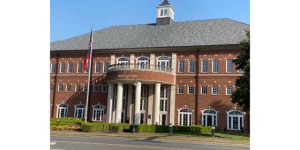Gardens, archives a ‘crown’ jewel for historical society
Published 8:50 am Friday, November 12, 2010
“Look up there at the top of the cotton mill tower,” says Erik Gallman, director of the Whitfleld-Murray Historical Society, “just below the tip of the weather vane. There’s a crown — and that is the crown of Crown Cotton Mills, and it is original!”
Trending
In the shadow of that 126-year-old tower, Gallman and his staff have toiled for the past 18 months to restore the Crown Archives, which served for decades as offices for the mill after being built in 1890, before the Hamilton family gave the building to the historical society in 1977.
“We found blueprints from a 1921 renovation,” Gallman says, “and we’re taking it back to that time as close as possible.”
That effort has meant a lot of elbow grease by local workers.
“When I started to work here, the main exhibit room was three rooms that had been partitioned off and there were ceiling tiles on the ceiling and pegboard on the wall,” he says. “We tore down the tiles and found the original beadboard underneath. We cleaned that up and painted it, and had the building rewired. We hid the wires in the coffered ceiling that we added.”
A glass wall through which the public interacted had been covered with layers of paint on both sides, so much “that you couldn’t tell the glass had texture to it,” Gallman says. “That took a lot of scrubbing to get that off. We’d just have to work on it until we got sick of doing it! And if you see wood anywhere in this building, we’ve had to strip the paint off it.”
The main exhibit room even features a historical sign reading “Crown Cotton Mill” that was found in a pile of treasures inside the Crown Mill Store, just up the street on Chattanooga Avenue.
Trending
Another treasure inside the Archives is the vault room, where all of the cotton mill financial records — payroll, production, accounts payable, bills — that go back to 1884 remained.
“We’ve cleaned out all the records from the vault and then started putting everything specifically related to the cotton mill back in there,” Gallman says. “It’s been catalogued by our interns so we know what it is and exactly where it is in here. So not only are we trying to preserve the building, but also preserve everything in it.”
Cecilia Sanchez, who graduated from Dalton High School in 2009 and just completed her first year at the University of Georgia, spent the summer interning at the archives.
“The main thing I was working on was the cataloging of all the ledgers from the Crown Cotton Mills, and all the payrolls,” she said. “Is it hard to do? Sometimes, yeah. I didn’t know where things should go or how I had to look at it and figure out what it was and then go from there.”
One unusual item inside the building is the original bookkeeping desk, which was actually built inside the room. “It will not come out unless you have a chainsaw,” Gallman says with a laugh. “Right now, it’s covered with a bunch of stuff, but when it’s not covered up, it’s really a nice piece of furniture.”
Gallman and his crew aren’t without a sense of humor.
“We have a bunch of mannequin parts stored here,” he says, “and I told a community service worker to go up there and put all the parts in one place so we could keep up with them. What she did is she set one up in the window, and I came into work the next day, forgot all about it. I looked up, and when I saw that ‘woman,’ it liked to have scared me to death!”
History even extends to the outside of the Archives, where a nearby concrete pond is actually the original water supply for the city of Dalton. A small brick building at one end is the pump house.
“They pumped the water up the hill, where there used to be a water tank,” Gallman explained. “They called that Stand Pipe Hill at the time. It supplied Thornton, Selvidge and Hamilton streets; we’re talking about 1898, that time frame.”
Gallman says a Boy Scout plans to make renovation of the pump house his Eagle project. “He’s going in there and painting everything and cleaning it up and doing a display so you can see how the old pumps would have worked.”
The goal, according to Gallman, is to make the Crown Gardens and Archives, now called the History Center, and the Hamilton House “an absolute showplace.”
The historical society hopes to tie the grounds of both structures together with a path in between, “and we’ve got a nice little chunk of land behind the Hamilton House that goes all the way to the four-way stop and then over to the railroad tracks,” he says.
They hope to eventually clean up that vacant land and put in walking trails featuring native plants.
“But we want to tie it all into history,” Gallman explains. “Like here’s this plant and this is how it was used as a substitute for some medicine during the Civil War, or this is how the Indians used that. We also want to have an heirloom garden up there — with what would have been period plants — grow some tobacco, some cotton, and tie the cotton in to the cotton mill. Grow some daffodils or violets, and tie that in to Robert Loveman,” the Dalton native who wrote “It isn’t raining rain to me — it’s raining violets.”
Basically, Gallman says, “just having little things out there in the garden that tie everything together to get people interested in history regardless of other things they’re interested in. If you’re interested in plants or you’re interested in arts, try to tie it all together.”
He sees the Crown Mill area being nurtured enough “that a visitor could come and spend a whole day just right here, especially if the city gets the old store fixed up.”
He hopes the city will find the funds to renovate the store so that it looks like it did during its heyday as a place for cotton mill employees to get all the items they needed to live.
“Then maybe in the back they could have a little café that just serves sandwiches for groups that are here doing tours, because a lot of times people will come and visit us here and say, ‘I’m just gonna run and get lunch, and we’ll be back.’ But once they leave and go get lunch, they never come back. But if we can keep them here busy all day, then maybe we’ve got them here in the county for another day spending more money here.”
The History Center offers Gallman and a fellow worker a chance to blend their talents.
“I’ve got a greenhouse business, and then I’ve actually got a teaching degree,” Gallman says. “I taught eighth grade for two years but decided that wasn’t the age group I wanted to teach, so I just went back totally to the greenhouse. As a hobby I paint on canvas historic buildings, and that’s how I got involved with the historical society. This job came open, and well, here I am.
“I enjoy it. I get to do something different every day. I like history, I like working with plants, and there’s actually another fellow, Sam Brown, who helps me and he’s a licensed landscape architect. As long as we can get some money and support, we’re planning on really sprucing it up. Sam’s got some ideas on how to do it, as far as walking trails and the grounds at Hamilton House. It can really be a showplace; it’s just going to take some time, money and interest from people.”
And interest is picking up, Gallman says. A recent sneak peek open house at the Archives drew a big crowd.
“It’s been very positive,” he said. “People come in and you get to see their jaws drop. A lot of them knew work was going on, but they didn’t know how far we’d gotten, and they didn’t know to what extent it was going on. Everybody is very surprised, very pleased with what is going on.”
Gallman says about $15,000 has been spent so far on the gardens and archives, with the city of Dalton, grant funds, in-kind contributions and corporate and individual donations making the work possible. Work on the Hamilton House has been done through a separate grant.
Once the work is completed later this year, the Archives will be used to exhibit local historical items on a rotating basis. One room will be used to store historical maps and newspapers, some all the way back to 1871, and thousands of pages of history books and ledgers will be available, including bound volumes of “War of the Rebellion — Official Records of the Union and Confederate Armies,” “Pioneer Mothers of America,” and the “National Register of the Sons of the American Revolution.”





